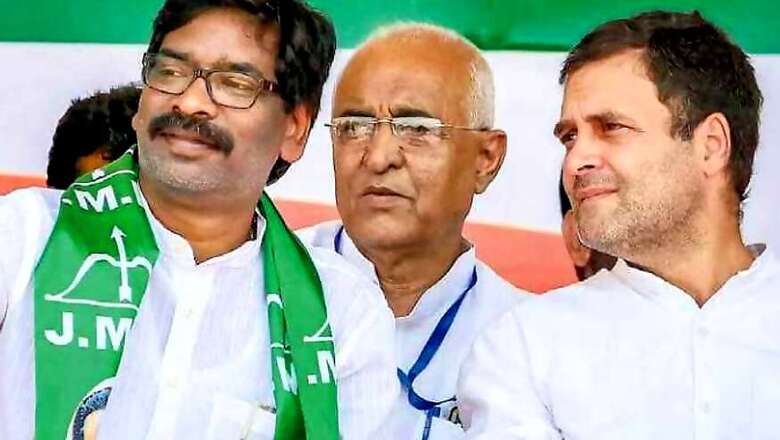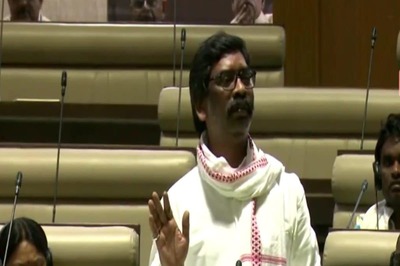
views
Patna/Ranchi: Ahead of the crucial five-phase Jharkhand assembly elections, all the major political parties and combinations made last-minute promises to garner the votes of the other backward castes (OBCs), especially the Kudmi-Mahato caste, and the Scheduled Tribes.
The Congress promised in its manifesto 27% reservation for the OBCs from the existing 14%, jobs to at least one person per household and a separate Sarna code (religious code) for the tribal population of Jharkhand if voted to power.
Bharatiya Janata Party (BJP) president Amit Shah at one of its election rallies also announced to form a commission for reservation to the backward caste youth and dole out jobs to them. Shah said that the BJP government would provide an opportunity to the OBCs, which have been neglected during 70 years of Congress rule in the country.
Simultaneously, the main opposition Jharkhand Mukti Morcha (JMM) led by Sibu Soren has pledged to provide 67% reservation to OBCs, Scheduled Tribes and Scheduled Castes besides government jobs to the local people if it came to power in the state. The JMM also promised an allowance of Rs 5,000 and Rs 7,000 per month to unemployed graduates and post-graduates besides reserving 75% jobs in the private sector for the local youth.
The Congress strategy in promising increase in reservation for the OBCs appears to be an attempt to snatch the OBC quota plank from the BJP and its disgruntled ally — the All Jharkhand Student Union (AJSU) Party, which has been championing the demand of the Kudmi-Mahato caste for its inclusion in the list of the Scheduled Tribes. The Kudmi-Mahatos constitute around 25 per cent of the total population of Jharkhand.
The higher OBC quota politics is also an attempt to blunt the demand of inclusion of the Kudmi-Mahato in the Scheduled Tribe list as it would require an amendment in Parliament. This attempt, at the same time, has the risk of alienating the substantial tribal population in Jharkhand.
But the offer will certainly have its bearing in the Chotanagpur region, which has substantial population of the Kudmi-Mahato caste. The Congress and others hope to rope in the support of the politically powerful and financially affluent Kudmi-Mahato caste.
The AJSU led by Sudesh Mahato had laboured under the BJP and been rendered redundant under the saffron shadow. But this time, it is trying to firm up its roots by deciding to field candidates against its BJP from 27 assembly seats and hopes to reap dividends from its core vote bank of the Kudmi-Mahato caste. In the 2014 polls, the BJP had won 37 seats in the 81-member Jharkhand assembly and it crossed the majority mark only with the help of five seats won by AJSU.
The Kudmi-Mahato caste of Jharkhand is ethnically and culturally different from the Kurmi caste of Bihar. They observe totems and taboos akin to Munda, Ho, Kharia, Oraon and Santhals. A central government notification of 1913 and notification of the then Bihar-Orissa government of 1931 suggest that Kudmis were part of the Scheduled Tribes. In the 1931 census, the Kudmis of Chotanagpur were included in the list of primitive tribes and it was a part of ST till September 5, 1950. The reason behind the omission of the caste from the list is not yet known.
Scholars like Dr Ram Dayal Munda, Dr Nirmal Minz, N E Horo, Sanjay Basu Mallick and Santosh Rana have observed that Kudmis of Jharkhand should be accorded the status of STs.
At the Adivasi Kudmi Convention held at Purulia on December 27, 1988, N E Horo in a written message stated that Kudmi community should be included into the ST list since they belonged to the ethnic group and remained part of it till 1931.
JMM patriarch Sibu Soren favoured inclusion of the Kudmi-Mahato into the list of Scheduled Tribes observing that they were a sub-caste of Santhals and branched out of the same clan. The then AICC general secretary Ram Ratan Ram had opined that the Kudmi-Mahatos were the tribesmen and promised to raise the issue with the then Prime Minister.
The Totemic Kudmi tribes are highly concentrated in Ranchi, Hazaribagh, Santhal Pargana and Chotanagpur plateau of Jharkhand, Mayurbhanj, Sundargarh, Keonjhar, Bonai in Orrisa and Purillia, Bankura and Midnapore, Burdan, Malda, Murshidabad and West Dinajpur in West Bengal. They have been traditionally settled in a well-defined territory bounded by four rivers Damodar, Kanshabati, Subarnarekha and Baitarni, which has been a part of lower Jharkhand.
The BJP is tactically playing safe on this issue although the then BJP government led by chief minister Arjun Munda had recommended to the Centre to provide tribal status to the Kudmi-Mahatos and Ghatwars in 2004.
The Rashtriya Janata Dal (RJD) too is in support of the demand and supported increase in the OBC quota and inclusion of Kudmi-Mahato in the ST list.
Jharkhand will vote in five phases, with the first one on November 30 and the last on December 20. Results will be declared on December 23.
(The author is a senior journalist.)
















Comments
0 comment